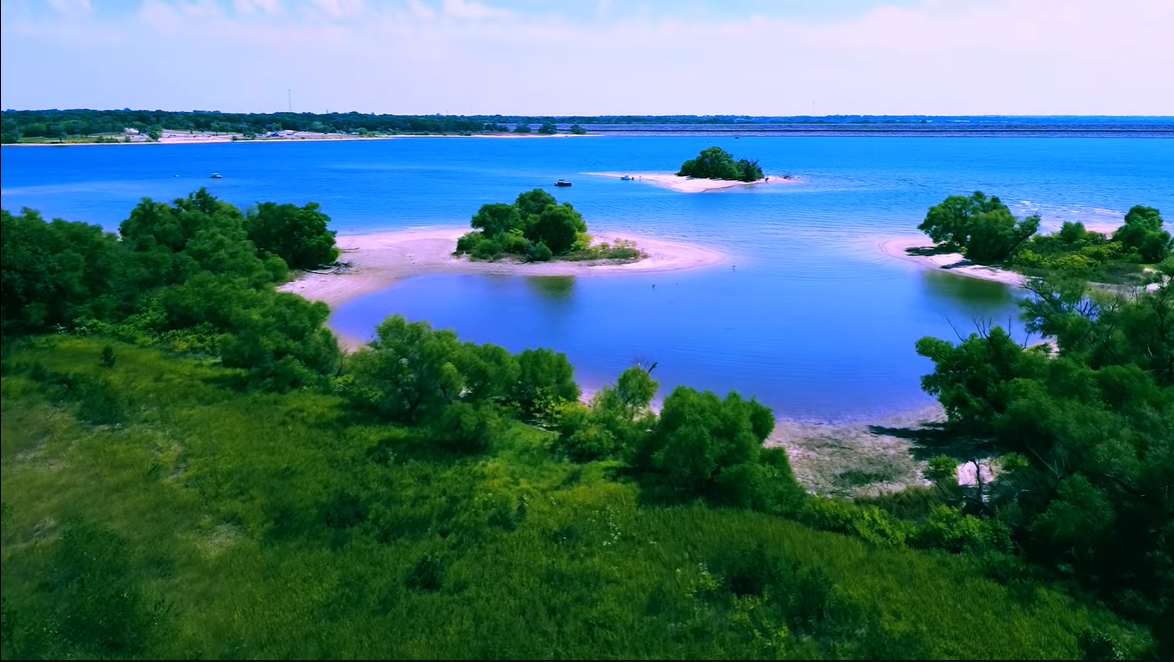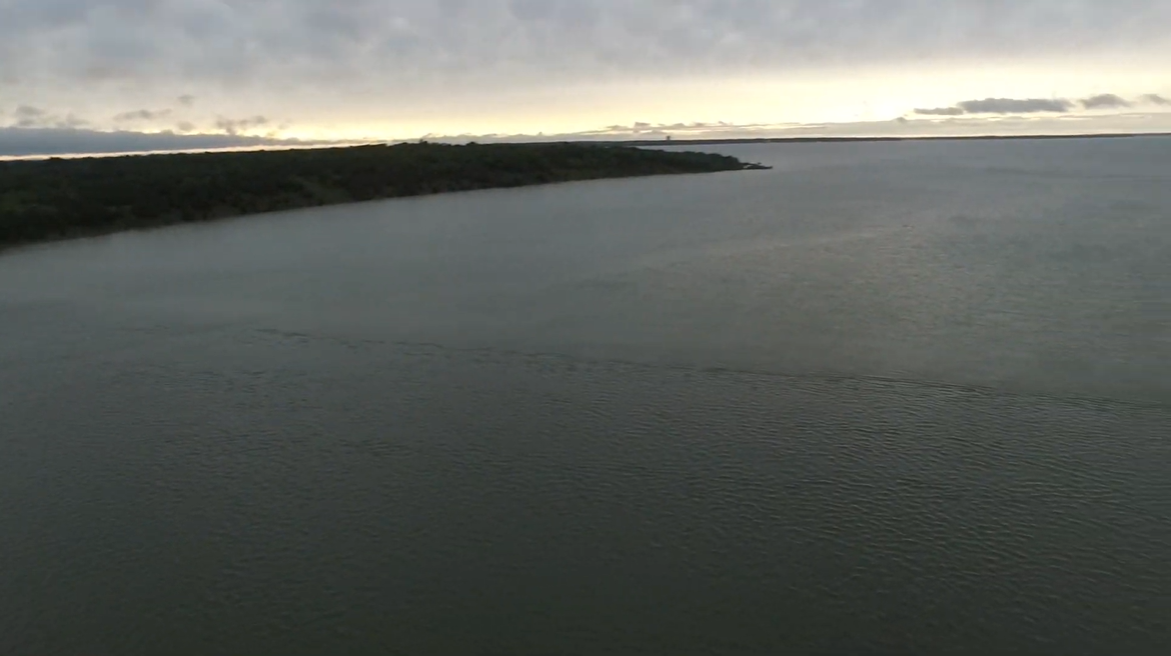Lake Texoma
Lake Texoma, one of the largest reservoirs in the United States, is a sprawling body of water situated on the border between Texas and Oklahoma. Formed by the impoundment of the Red River and the Washita River, this lake serves as a vital resource for flood control, hydroelectric power, water supply, and recreational activities. Managed by the U.S. Army Corps of Engineers, Lake Texoma is a premier destination for outdoor enthusiasts, attracting millions of visitors annually.
.png) |
| Lake Texoma |
History and Formation
The construction of Denison Dam on the Red River in the 1940s led to the creation of Lake Texoma. The dam was authorized by the Flood Control Act of 1938 and was completed in 1944 to provide flood control and hydroelectric power to the surrounding regions. Spanning over 89,000 acres with a shoreline stretching approximately 580 miles, the lake is among the largest artificial reservoirs in the United States. The impoundment of the Red and Washita Rivers contributed to the lake’s rich aquatic ecosystem, making it an ideal habitat for various fish species and wildlife.
.png) |
Denison Dam
|
Geographical and Hydrological Features
Lake Texoma lies within the Texoma region and is bordered by Grayson County in Texas and Bryan, Marshall, and Johnston Counties in Oklahoma. It has a maximum depth of about 100 feet and an average depth of approximately 39 feet. The lake’s water levels fluctuate based on rainfall, dam releases, and regional water consumption. Two major inflows, the Red River and Washita River, supply the lake with water, while the dam's outflow helps regulate flooding in downstream communities.
Recreational Opportunities
Lake Texoma is a popular recreational hub offering diverse activities such as fishing, boating, swimming, camping, and hiking. The lake is famous for its striped bass fishing, with natural reproduction supporting a thriving population. Other fish species include catfish, largemouth bass, crappie, and bluegill.
Numerous marinas, boat ramps, and campgrounds dot the shoreline, providing ample facilities for visitors. The lake is home to multiple state parks, including Eisenhower State Park in Texas and Lake Texoma State Park in Oklahoma, both of which offer scenic trails, picnic areas, and wildlife observation opportunities. For boating enthusiasts, the vast expanse of open water allows for sailing, jet skiing, and kayaking.
.png) |
Lake Texoma
|
Wildlife and Ecology
Lake Texoma supports a diverse range of flora and fauna. The surrounding landscape is characterized by rolling hills, hardwood forests, and grasslands, creating an ideal environment for birdwatching and wildlife photography. Bald eagles, herons, egrets, and migratory waterfowl frequent the lake’s ecosystem. The rich aquatic life supports a variety of fish species, while the surrounding woodlands provide habitat for deer, bobcats, and other wildlife.
Economic and Environmental Impact
The lake plays a significant role in the local economy, generating revenue through tourism, fishing tournaments, and recreational services. Numerous resorts, cabins, and restaurants cater to visitors, making Lake Texoma a key contributor to the regional economy. Additionally, the lake provides an essential water source for local municipalities and industries.
Environmental conservation efforts have been implemented to maintain water quality and protect the lake’s ecosystem. Programs addressing erosion control, invasive species management, and sustainable fishing practices help preserve Lake Texoma’s natural beauty and ecological balance.
Conclusion
Lake Texoma stands as a remarkable example of human ingenuity and natural beauty combined. From its origins as a flood control reservoir to its current status as a beloved recreational destination, the lake continues to serve as a vital resource for both Texas and Oklahoma. Whether one seeks adventure on the water, relaxation along the shoreline, or an opportunity to appreciate the region’s diverse wildlife, Lake Texoma remains a cherished gem of the Red River basin.
FAQs
Q. Where is Lake Texoma?
A. Lake Texoma is located on the border between the states of Texas and Oklahoma in the United States. The reservoir spans across both states and is formed by the Denison Dam on the Red River. The dam is situated near the town of Denison in Texas. The lake's extensive shoreline stretches into both Texas and Oklahoma, making it a popular destination for residents of both states for various recreational activities.
Q. How many square miles is Lake Texoma?/How long is Lake Texoma?/How many miles of shoreline does Lake Texoma have?
A. Lake Texoma is one of the largest reservoirs in the United States. It covers an area of about 89,000 acres, which is equivalent to approximately 360 square kilometers. In addition to its substantial surface area, the lake has a lengthy shoreline that extends for over 580 miles, or about 930 kilometers.
Q. How deep is Lake Texoma?/What is the depth of Lake Texoma?/What is the deepest part of Lake Texoma?
A. Lake Texoma has varying depths throughout its expanse. The average depth of the lake is around 60 feet (18 meters). However, the maximum depth can reach up to approximately 100 feet (30 meters) in certain areas.
Q. When was Lake Texoma built?/How was Lake Texoma made?/When was Lake Texoma made?
A. Lake Texoma was constructed as part of a project involving the Denison Dam on the Red River. The construction of the dam began in 1939 and was completed in 1944. The dam and reservoir were built for multiple purposes, including flood control, hydroelectric power generation, and the supply of water for municipal, industrial, and agricultural needs.
The Denison Dam, which impounds Lake Texoma, was named after the nearby town of Denison, Texas. The completion of the dam marked the formation of Lake Texoma, which has since become one of the largest and most popular reservoirs in the United States.
Lake Texoma Photos (Picture of Lake Texoma)
.png) |
| Lake Texoma |
.png) |
| Lake Texoma |
.png) |
| Lake Texoma |
.png) |
| Lake Texoma |
.png) |
| Lake Texoma |
.png) |
| Lake Texoma |
.png) |
| Lake Texoma |
.png) |
| Lake Texoma |
.png) |
| Lake Texoma |
.png) |
| Lake Texoma |
.png) |
| Lake Texoma |
.png) |
| Lake Texoma |
.png) |
| Lake Texoma |
.png) |
| Lake Texoma |
.png) |
| Lake Texoma |
.png) |
| Lake Texoma |
.png) |
| Lake Texoma |
.png) |
| Lake Texoma |
.png) |
| Lake Texoma |
.png) |
| Lake Texoma |
.png) |
| Lake Texoma |
.png) |
| Denison Dam |
.png) |
| Denison Dam |
.png)
.png)
.png)
.png)
.png)
.png)
.png)
.png)
.png)
.png)
.png)
.png)
.png)
.png)
.png)
.png)
.png)
.png)
.png)
.png)
.png)
.png)
.png)
.png)
.png)
.png)

No comments:
Post a Comment